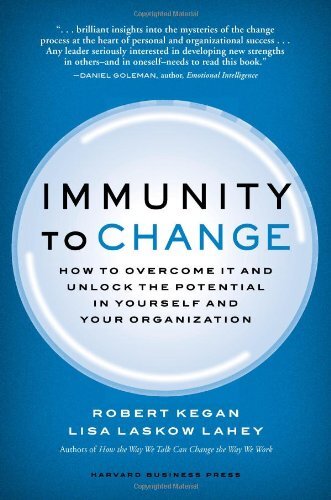Robert Kegan and Lisa Laskow Lahey, Immunity to Change: How to Overcome It and Unlock the Potential in Yourself and Your Organization (Harvard Leadership for the Common Good Series). Harvard Business School Press, 2009.
Referenced in: Change Concepts and Theories
LifeandLeadership.com Summary
This is a weighty, academic text addressed to business leaders, but it translates well into churches. It is an expanded look at one important piece of change management, dealing with natural resistance to change. It is a good companion volume to Hultmann’s Making Change Irresistible.
Kegan and Lahey place their work in the larger block of literature on organizational change by pointing out that most authors have not given serious attention to adult development, operating on the belief that the brain changes very little after adolescence. Recent neuroscience challenges this, and this book draws out the implications for organizational leadership.
Part One, Chapters 1-3, explains the principles of change immunity. The opening chapter looks at this from a densely theoretical viewpoint, affirming that in both leaders and organizations there is a correlation between effectiveness and intentional cognitive development, self-transformation, and embrace of complexity. Chapter 2 explores their theory of immunity to change, especially as it relates to adaptive change (cf. Heifetz). They offer three premises for overcoming that immunity. First, it does not require letting go of all anxiety management systems. Second, it is not change itself but the feeling of defenselessness in it that produces anxiety. Third, immunity systems can be changed. In chapter 3, they show how each person who resists change can be led to identify the “one big thing” that feeds their immunity. They offer a four column system to be used for that purpose.
Part two, Chapters 4-7, discuss how to overcome immunity to change in organizations, individuals, and teams. In chapter 4, they discuss how groups have used the four column system, supplemented by immunity maps, surveys, pilot projects, etc. to become more effective learners. Chapters 5-7 presents cases of how individuals and organizations have actually changed behaviors through immunity work.
Part three, chapters 8-11, presents the practical steps of diagnosing and overcoming change immunity. The initial focus is on individuals. Here they discuss the pre-ingredients necessary to begin the work, and how to use the four-column system and immunity map to uncover why “you want to save your life as you know it” (253). They offer a step-by-step process for evaluating one’s self-image or identity and how this shapes one’s immunity. They show how to test the underlying assumptions and experience the limits of this identity, and how to start constructing a new identity and enter new practices to release the grip of the immunity system. Chapter 11 shows how to follow the same process for a group. The conclusion of the book helpfully summarizes key concepts.
This book is fascinating. Probably the best way to read it is to begin with the conclusion and start your way back if you think it would be useful. There are many potential uses for those who would be disciplined enough to read it through and then follow the system, perhaps to work with key leaders whose immunity to change is especially cumbersome for their congregations.
From the Publisher
A recent study showed that when doctors tell heart patients they will die if they don’t change their habits, only one in seven will be able to follow through successfully. Desire and motivation aren’t enough: even when it’s literally a matter of life or death, the ability to change remains maddeningly elusive. Given that the status quo is so potent, how can we change ourselves and our organizations?
In Immunity to Change, authors Robert Kegan and Lisa Lahey show how our individual beliefs—along with the collective mind-sets in our organizations – combine to create a natural but powerful immunity to change. By revealing how this mechanism holds us back, Kegan and Lahey give us the keys to unlock our potential and finally move forward. And by pinpointing and uprooting our own immunities to change, we can bring our organizations forward with us.
This persuasive and practical book, filled with hands-on diagnostics and compelling case studies, delivers the tools you need to overcome the forces of inertia and transform your life and your work.
About the Author
Robert Kegan and Lisa Lahey, coauthors of How the Way We Talk Can Change the Way We Work, have been research and practice collaborators for twenty-five years. Kegan is the William and Miriam Meehan Professor in Adult Learning and Professional Development at Harvard University’s Graduate School of Education. Lahey is the Associate Director of Harvard’s Change Leadership Group and a founding principal of Minds at Work, a leadership-learning professional services firm.
***For additional information on this resource, including reviews, click the bookstore links. Check the reference at page top or the links below for resource guides on related topics.***
Related Areas
See Other Resources on Change and Transition in Churches:
- Change and Transition in Churches, Intro
- Change Concepts and Theories
- Change Receptiveness and Resistance
- Leading Change and Transition
See Resource Guides on Over 100 Areas of Ministry Leadership:


